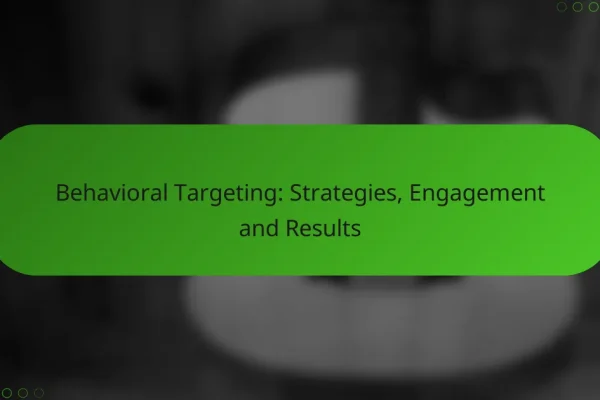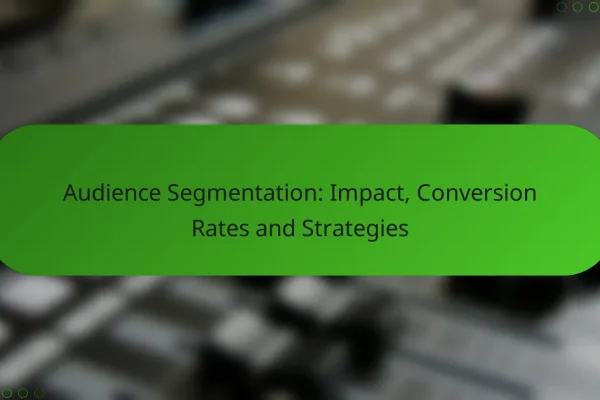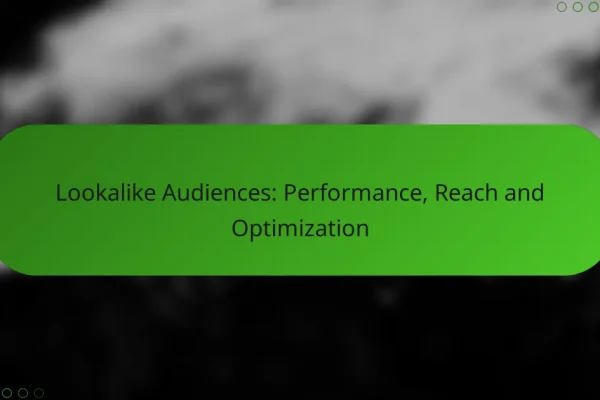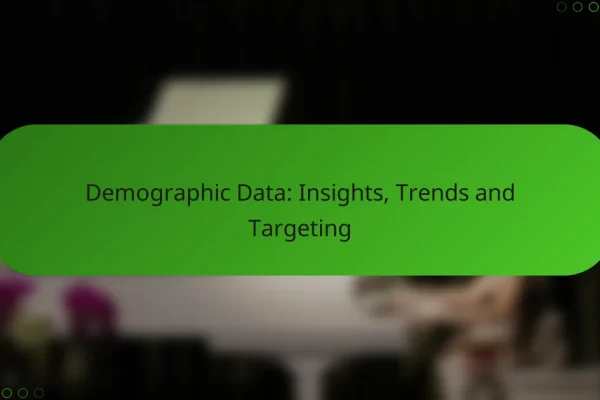How to segment target audiences for display advertising?
Segmenting target audiences for display advertising involves categorizing potential customers based on shared characteristics. This process helps in creating tailored ads that resonate with specific groups, ultimately improving engagement and conversion rates.
Demographic segmentation
Demographic segmentation divides audiences based on quantifiable characteristics such as age, gender, income, education, and marital status. For instance, a luxury brand may target high-income individuals aged 30-50, while a children’s toy company might focus on parents aged 25-40.
When implementing demographic segmentation, consider using data from surveys, social media insights, and customer databases to refine your audience. This approach allows for more personalized messaging that aligns with the interests and needs of each demographic group.
Behavioral segmentation
Behavioral segmentation categorizes audiences based on their interactions with your brand, including purchasing behavior, usage frequency, and brand loyalty. For example, frequent buyers may receive exclusive offers, while occasional users might be targeted with reminders or incentives to return.
To effectively use behavioral segmentation, track user actions through analytics tools and adjust your advertising strategies accordingly. This method enhances customer engagement by addressing specific behaviors and preferences.
Geographic segmentation
Geographic segmentation focuses on the location of your audience, which can significantly influence purchasing decisions. This can include targeting by country, region, city, or even specific neighborhoods. For instance, a winter clothing retailer may target colder regions during the winter months.
Utilizing geographic data allows for more relevant advertising, as it considers local trends and cultural differences. Tailoring messages to specific locations can improve the effectiveness of your campaigns and increase local engagement.
Psychographic segmentation
Psychographic segmentation categorizes audiences based on their lifestyles, values, interests, and personality traits. This approach helps in understanding the motivations behind consumer behavior, allowing for more emotionally resonant advertising. For example, eco-conscious consumers may respond better to brands that emphasize sustainability.
To implement psychographic segmentation, conduct surveys or focus groups to gather insights into your audience’s values and interests. This information can guide creative strategies and messaging that align with your target audience’s beliefs.
Technographic segmentation
Technographic segmentation involves categorizing audiences based on their technology usage, including devices, software, and online behaviors. For instance, a mobile app developer might target users who primarily access services via smartphones.
Understanding the technology preferences of your audience can help tailor your advertising formats and channels. For example, if your target audience predominantly uses social media on mobile devices, prioritize mobile-friendly ads to enhance user experience and engagement.
What tools can assist in audience segmentation?
Several tools can effectively assist in audience segmentation, enabling marketers to identify and target specific groups within their audience. These tools provide valuable insights into user behavior, demographics, and preferences, which can enhance advertising strategies.
Google Analytics
Google Analytics is a powerful tool that offers detailed insights into website traffic and user behavior. By setting up goals and tracking user interactions, marketers can segment audiences based on demographics, interests, and engagement levels.
To utilize Google Analytics for audience segmentation, create custom segments that reflect specific user behaviors, such as high engagement or frequent purchases. This allows for targeted advertising campaigns that resonate with particular audience segments.
Facebook Audience Insights
Facebook Audience Insights provides data on the demographics, interests, and behaviors of users on the platform. This tool helps marketers understand their audience better and tailor their advertising strategies accordingly.
Using Facebook Audience Insights, you can create audience segments based on criteria like age, location, and interests. This targeted approach can lead to more effective ad campaigns, as it allows for personalized messaging that aligns with user preferences.
Adobe Audience Manager
Adobe Audience Manager is a data management platform that enables marketers to collect and analyze audience data from various sources. It helps in creating detailed audience profiles, which can be used for more precise targeting in advertising campaigns.
With Adobe Audience Manager, you can leverage first-party and third-party data to build audience segments. This tool is particularly useful for large organizations that require advanced segmentation capabilities to optimize their advertising efforts across multiple channels.
What are the benefits of effective audience segmentation?
Effective audience segmentation enhances the precision of display advertising by allowing marketers to tailor their messages to specific groups. This targeted approach leads to better engagement and maximizes the impact of advertising efforts.
Increased ad relevance
Increased ad relevance occurs when advertisements are tailored to the interests and behaviors of specific audience segments. By analyzing demographic, geographic, and psychographic data, marketers can create ads that resonate more with their target audience. For example, a sports brand may target young adults interested in fitness with ads featuring activewear, while promoting casual wear to a broader audience.
To achieve this, consider using data analytics tools to gather insights on your audience’s preferences and behaviors. This information can guide your ad creative and messaging, ensuring that your campaigns are more relevant and engaging.
Higher conversion rates
Higher conversion rates are a direct result of delivering relevant ads to the right audience. When potential customers receive messages that align with their interests, they are more likely to take action, whether that means clicking on an ad or making a purchase. For instance, personalized email campaigns often see conversion rates that are significantly higher than generic messages.
To boost conversion rates, implement A/B testing on your ads to identify which messages and visuals perform best with different segments. This iterative approach allows you to refine your strategy and improve overall effectiveness.
Improved ROI
Improved ROI is achieved when advertising budgets are spent more efficiently through targeted campaigns. By focusing on specific segments that are more likely to convert, businesses can reduce wasted ad spend and increase overall profitability. Companies that effectively segment their audiences often see returns that are several times higher than their initial investment.
To enhance ROI, regularly review and adjust your audience segments based on performance metrics. This ongoing optimization ensures that your advertising efforts remain aligned with market trends and consumer behavior, maximizing returns over time.
What criteria should be considered for audience segmentation?
Effective audience segmentation in display advertising requires careful consideration of various criteria to ensure targeted messaging. Key factors include market research data, customer behavior analysis, and understanding the competitive landscape.
Market research data
Market research data provides insights into demographics, interests, and purchasing behaviors of potential customers. This data can be gathered through surveys, focus groups, and industry reports. Utilizing this information helps in identifying specific segments that are more likely to engage with your advertising.
For instance, if research indicates that a particular age group shows a strong interest in eco-friendly products, advertisers can tailor their campaigns to resonate with that demographic. Regularly updating this data is crucial to adapt to changing market trends.
Customer behavior analysis
Analyzing customer behavior involves examining how individuals interact with your brand and similar products. This includes tracking online activities, purchase history, and engagement levels across various platforms. Understanding these behaviors allows advertisers to create more personalized and relevant ads.
For example, if data shows that a segment frequently browses outdoor gear but rarely makes a purchase, targeted ads offering discounts or promotions could encourage conversions. Tools like Google Analytics can help track these behaviors effectively.
Competitive landscape
Evaluating the competitive landscape involves assessing how competitors target their audiences and what strategies they employ. This analysis can reveal gaps in the market or opportunities for differentiation. By understanding competitors’ strengths and weaknesses, advertisers can refine their own segmentation strategies.
For example, if competitors are focusing heavily on social media ads targeting millennials, a brand might consider a different approach, such as email marketing to reach older demographics. Keeping an eye on competitors’ campaigns can provide valuable insights for improving your own audience targeting.
How to evaluate the effectiveness of audience segmentation?
Evaluating the effectiveness of audience segmentation involves analyzing how well your targeted groups respond to display advertising. Key metrics include engagement rates, conversion rates, and return on ad spend (ROAS).
Key performance indicators (KPIs) to track
To measure the effectiveness of audience segmentation, focus on specific KPIs such as click-through rates (CTR), conversion rates, and customer acquisition costs (CAC). These indicators provide insights into how well your ads resonate with different segments.
For instance, a CTR above 2% is generally considered good for display ads, while a conversion rate of 5% or higher is often seen as effective. Tracking these metrics over time helps identify which segments are performing well and which need adjustment.
Methods for analyzing audience response
Use A/B testing to compare different audience segments and their responses to various ad creatives. This method allows you to see which messages or visuals resonate best with each group.
Additionally, employing analytics tools can help you visualize data trends and segment performance. Tools like Google Analytics or Facebook Ads Manager provide detailed insights into user behavior and engagement.
Adjusting strategies based on data
Once you have collected data, adjust your strategies accordingly. If certain segments show low engagement, consider refining your messaging or targeting criteria to better align with their interests.
Regularly revisiting your audience segmentation strategy is crucial. Market trends and consumer preferences change, so staying agile and responsive to data insights will enhance your advertising effectiveness over time.











